
If you watched the ceremonies (of course you did!) prior to the Canadiens home opener on Wednesday, you were no doubt treated to the first wave of pomp and circumstance having to do with the Canadiens one hundreth anniversary.
As the old saying goes, only the Montreal Canadiens and the Catholic Church truly understand ceremony. If you've been a Habs fan for any length of time, you know that the Canadiens do this well simply because practice makes perfect.
I always liked the comparison to the church - kinda like God and the Habs, hand in hand.
For the younger generation, watching such things as the centennial unfold has got to be quite the series of discoveries.
I have a younger friend of mine, who has been a Canadiens fan for about 10 years, who is just now starting to get caught up in the history of the team. Each time he sees me, he almost runs to me with a new curiosity.
I can tell there is a Habs related question just by his expression.
When did this or that happen? Who was the guy that used to wear number 12? How come, in my EA Hockey '09, there's a Habs goalie that catches with both hands?
T.J. is a fun kid to talk Habs with, cause he's so inquisitive. He's a real pleasant chat, a studious listener. and has the fun habit of enunciating Vezina like "vagina".
I was thinking of him, and youngsters his age while watching the Canadiens unveil the Ring Of Honour on wednesday. They must wonder aloud who all these legends are, and why anyone would still care today.
The simple truth is that the Canadiens, unlike some other organizations when they change regimes, do not forget their history. Their fans do not allow them to forget their history. Their history does not let the team forget it's history.

"So who were those two old geezers at center ice for the ceremonial faceoff?"
"Ninety year old versions of Gretzky and Pronger", I offer, to a twisted look and a raised eyebrow.
Emile "Butch" Bouchard and Elmer Lach were the best in their time, that being the 1940's to mid 1950's, and they marked the game and their era by making such lasting impressions that, in 2008, what they achieved translates into long, more than deserved ovations by the gathered fans.
Don't take it from me - I wasn't even close to being there!
I first heard these names at the foot of my father's coach.
"He's good, but he's no Butch Bouchard!"
"Elmer would have found that open winger!"
Over time, through reading tons, the odd clips, and testemonials from the day, the impact of Lach and Bouchard on Canadiens history is easily rendered.
 From the mid 1930's to 1941, the Canadiens were such a dismal operation, that they bordered on extinction. Had it not been for the cross town rival Montreal Maroons being even worse, the Canadiens in fact might not exist today. Believe it or not, the team was tanked so badly by brutal management (The Canadian Arena Company owned both the Maroons and Habs.) that it seriously contemplated a move to St. Louis. NHL wisdom, led by the Maple Leafs owner Conn Smythe, stood up against such silliness.
From the mid 1930's to 1941, the Canadiens were such a dismal operation, that they bordered on extinction. Had it not been for the cross town rival Montreal Maroons being even worse, the Canadiens in fact might not exist today. Believe it or not, the team was tanked so badly by brutal management (The Canadian Arena Company owned both the Maroons and Habs.) that it seriously contemplated a move to St. Louis. NHL wisdom, led by the Maple Leafs owner Conn Smythe, stood up against such silliness.By the early 1940's, the Canadiens needed heroes, and some serious salvaging. They slowly began getting their act together, and pieces one by one, began falling into place.
The Canadiens team of that era, was not unlike the Habs squads from 1996 to 2003. Both edition's desperately searched for direction.
In 1940, Montreal received a gift from the Toronto Maple Leafs, when they fired head coach Dick Irvin Sr. At Irvin's first training camp that fall, a centerman named Elmer Lach from Saskatoon, was given a tryout. Irvin knew how to recognize talent.
Lach had also slipped through the Leafs fingers. After Toronto's Smythe termed Lach a "peanut" to his face, Elmer bolted town with his tryout money in hand. Two seasons later, he easily impressed Irvin with his smooth passes and reckless demeanor. Accompanying Lach by train was another hardnose warrior, defenseman Ken Reardon.
One camp later, in 1941, it was Bouchard's turn to impress the coach. Bouchard had played in the Canadiens system for a season, showing surprising progression for a kid who had only begun skating at age 17. Four seasons later, he wanted to make the Canadiens so badly, he would bike the roughly 25 km trek from Longueuil to the Habs camp in St. Hycinthe. Not only was the youngster in better physical shape than most veterans on the club, Bouchard had the strength of an ox and the perseverance of a mad bull.
 When Irvin teamed Bouchard with Reardon, and Lach with veteran Toe Blake and a rookie named Maurice Richard, the Canadiens quickly became competitive and respected. Their darkest age, was now in the past. Not long thereafter, the Canadiens became acquainted with glory, winning Stanley Cups in 1944 and 1946, while Lach and Bouchard became perenial All Stars.
When Irvin teamed Bouchard with Reardon, and Lach with veteran Toe Blake and a rookie named Maurice Richard, the Canadiens quickly became competitive and respected. Their darkest age, was now in the past. Not long thereafter, the Canadiens became acquainted with glory, winning Stanley Cups in 1944 and 1946, while Lach and Bouchard became perenial All Stars.Lach won the Art Ross Trophy twice, and the Hart Trophy once, and had three first team All Star nods to go along with a pair of second team merits. In 1954, he retired as the NHL's all time leader is assists and points.
In Bouchard's day, the Norris Trophy had yet to be awarded, but his stature in the game is shown by his four successive All Star team berths, starting with the second team in 1944, followed by three first team awards from 1945 to 1947. As coach Irvin had often stated, had there been a Conn Smythe Trophy for playoff MVP in the day, his vote in '44 and '46 would have gone to Bouchard.
 What characterized both players was their toughness in the trenches. They achieved their iconic statures because they were warriors without compromise. Bouchard was not only one of the bigger and tougher players of his era, but he never hesitated to let his size speak, threaten, and hinder. As fearsome as he was on the ice, he soon became the ultimate leader off the ice and in the Canadiens fan community.
What characterized both players was their toughness in the trenches. They achieved their iconic statures because they were warriors without compromise. Bouchard was not only one of the bigger and tougher players of his era, but he never hesitated to let his size speak, threaten, and hinder. As fearsome as he was on the ice, he soon became the ultimate leader off the ice and in the Canadiens fan community.Lach was often a daredevil on skates. His fearlessness led to an injury plagued career, but only in extreme cases did it keep him from game action. During his time Lach broke elbows, wrists, ankles, and fractured his skull. His nose bore the brunt of his recklessness, though bent and twisted as it was, the player was a persevering non complainer who lived to compete. Somehow, through all this, coach Irvin nicknamed him "Elegant Elmer", because of his on ice prowess.
 The roles played by Bouchard and Lach on the ice were a mere fraction of their contribution. They were cornerstones in launching the Canadiens into greatness.
The roles played by Bouchard and Lach on the ice were a mere fraction of their contribution. They were cornerstones in launching the Canadiens into greatness.By 1943, the Montreal Canadiens were nothing more than one of six NHL teams, differentiated perhaps by a Flying Frenchmen flavor. They had won four Stanley Cups in 33 years of existance, as the NHL's oldest franchise, but the clubs that joined the Canadiens in the late 1920's were rapidly gaining ground. The Detroit Red Wings, New York Rangers and Boston Bruins had won three Cups, and the Maple Leafs and Blackhawks had a pair of championships to their credit, at that point.
In the following decade, the Canadiens would leave the other five clubs in the dust in terms of Cups wins. Much of the credit for the Canadiens greatest seasons and accomplishments are often found under the resumes of Maurice "Rocket" Richard and Jean Beliveau - and rightly so!

While there is no denying the individual greatness of these two Habs icons, it is perhaps lost to history what influence and example Lach and Bouchard laid as groundwork.
Lach was the centerman on the Punch Line, perhaps hockey's greatest trio ever. On the left side was a devilishly driven Toe Blake, who reached his potential as a player while centered by Lach. Blake surely learned a great deal about the game in his most productive seasons, and what he garnered in observations surely translated into the excellent coaching career that followed.
Elegant Elmer was also the Rocket's centerman. In the season that Richard scored 50 goals in 50 games, Lach was the NHL's leading scorer with 26 goals and 54 assists. The assist mark and point total, while not having the Rocket's benchmark headline worthiness, were amazing accomplishments in their own right. At season's end, Lach was awarded the Hart Trophy as the NHL's MVP. In today's hindsight, it seems an erroneous choice given what Richard did, but at the time the merit sought to award what was at the core of greatness. While some may have grumbled that the award passed Rocket by in his greatest moment, no one has ever disputed that Lach was the grease that kept the wheels turning.
It should be seen that Lach was the churning gear that propelled the Rocket's motor. That truly is Lach's legacy - lighting the Rocket's fuse!
 Butch Bouchard's passing of the torch is much more testimonial that it is statistical. In fact, it might even be something more felt than it was seen, more emotional than it could ever be thought or pondered.
Butch Bouchard's passing of the torch is much more testimonial that it is statistical. In fact, it might even be something more felt than it was seen, more emotional than it could ever be thought or pondered.Emile Bouchard, through his on ice accomplishments, transcended for many, what it implied to be a Quebec born Montreal Canadiens player. Prior to him, few wore the jersey with more pride and distinction, or matched his commitment and dedication to what the CH logo represented in the hearts of locals.
Bouchard was a lunchpail common whose work ethic not only inspired, but provided a crystal clear vision for a great many Montreal Canadiens hopefuls. His contribution to the club is as vital as that of Georges Vezina, Didier Pitre and Newsy Lalonde's in establishing the hockey team's identity some thirty years earlier
 After seven seasons in the league, Bouchard inherited the team's captaincy from Blake, and the example he set laid out a template for every team captain who followed.
After seven seasons in the league, Bouchard inherited the team's captaincy from Blake, and the example he set laid out a template for every team captain who followed.He was gracious, accommodating, respectful, persevering and yet, humble. Bouchard met all public functions, represented the club with a dignity rarely seen for a hockey player, and sought to give something back to his community well before it was advantagious to a player's public persona to do so.
In his time, he used his name to help build outdoor rinks in impoverished areas of the city of Montreal, where the city's poorer kids could play hockey. He was a trailblazer in such notions. Hockey's millionaires of today do such things in recognicent blinks, without sacrificng an ounce of sweat. Bouchard made it his mandate. All he was doing then, on a salary that was far less than his overall worth, was giving back.
 The 2008-09 Canadiens organization honoured his endeavors without mentioning his name, when they announced they would build five outdoor rinks in the Montreal area.
The 2008-09 Canadiens organization honoured his endeavors without mentioning his name, when they announced they would build five outdoor rinks in the Montreal area.Bouchard allowed and accepted all such demands and intrusions into his life with grace, decency and a compassion for his public - one that absolutely adored him in his day.
 Today, Butch Bouchard is often remembered as the Montreal Canadiens first Quebec born captain. What he truly gave as a player and person, is best epitomized in the man that became Jean Beliveau. In class and substance Bouchard was Beliveau's template.
Today, Butch Bouchard is often remembered as the Montreal Canadiens first Quebec born captain. What he truly gave as a player and person, is best epitomized in the man that became Jean Beliveau. In class and substance Bouchard was Beliveau's template.Elmer and Butch were pillars - the cement of the foundation that is the Montreal Canadiens.
Cement is heavier to raise to the glorious Canadiens rafters than cloth, but with a lot of hands pulling....
Numbers 3 and 16 in Lach's name, have more than earned their place among the greatest of Habs players.
Here's hoping that fate allows those jersey to go heavenly before their precious souls do.

Visit the Bouchard and Lach bios at the HHOF site, and at Bouchard's amazing fan site.
Also check out T.C. Denault's excellent piece on Bouchard at the Habs World site.



















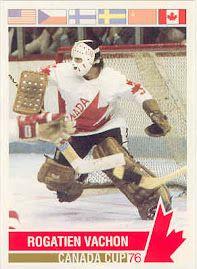
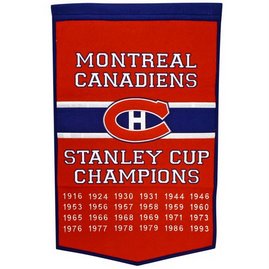







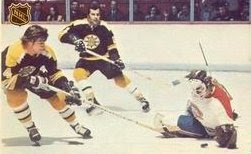



















































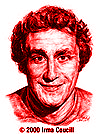



































































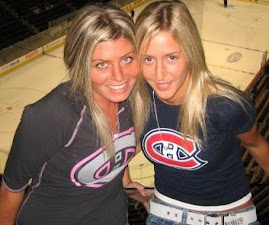


















1 comment:
For even more on "Butch" Bouchard.
http://www.habsworld.net/article.php?id=1640
T.C.
tc.denault@habsworld.net
Post a Comment